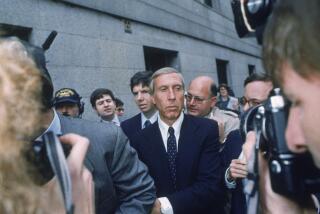The really juicy details behind the Lehman Bros. collapse
- Share via
It is not often that a book on the financial crisis makes you want to get a big bowl of popcorn.
But Vicky Ward’s page-turning yarn about Lehman Bros., the failed investment bank, is the closest thing to a bodice-ripper that the 2008 meltdown is likely to produce.
Ward, a contributing editor at Vanity Fair magazine, backs up from Lehman’s tragic collapse to take a look at nearly three decades of backstabbing and greed. Her book is “The Devil’s Casino: Friendship, Betrayal, and the High Stakes Games Played Inside Lehman Brothers,” published by Wiley.
She has interviewed most of the key players as well as selected wives, ex-wives and even, rather dramatically, held a seance to contact the ghost of the man Ward believes was the true heart of Lehman, former President Chris Pettit.
This is not a book for people who care about the geeky details of what went wrong with the global banking system.
Collateralized debt obligations rate just two mentions in the index, and credit default swaps get a paragraph and a half.
But “The Devil’s Casino” has everything readers might want to know about the personal foibles and shopping habits of key Lehman leaders and their wives.
Ward writes about helicopter rides and corporate jets, multimillion-dollar art collections and constant backbiting.
Few people come off well. Erin Callan, the first female chief financial officer at a big Wall Street bank, annoyed her colleagues by becoming blonder, more toned and better dressed as she rose through the ranks — and then embarrassed them by talking to the media about her personal shopper, according to Ward.
Andrew Kirk, the ambitious head of high-yield debt, got docked $1 million for insisting the company-chartered bus change its route and drop him off at his home first after the 2007 company Christmas party, Ward writes.
But for all the book’s apparent fluffiness, Ward hones in on Lehman’s central problems better than even she could have known. In a series of incidents stretching back decades, she shows how Lehman’s traders routinely hid the riskiness of their trades from senior managers and the public.
In the 1970s, they pulled index cards off the wall when the supervising partner came to visit so that he would not realize they were exceeding their position limits in intraday trading. In 2006, she writes, top management sidelined the chief risk officer for daring to suggest that house prices might fall.
The report by the bankruptcy examiner that Lehman had used an accounting trick nicknamed Repo 105 to shrink its balance sheet by millions of dollars at quarterly reporting periods clearly came from a long tradition, even if the report came out too late to be included in Ward’s book.
In spite of Ward’s extensive interviews, there are some gaping holes. She writes that a lawyer for Dick Fuld, the Lehman chief executive, would not permit Fuld to speak to her.
Joe Gregory, the president and chief operating officer who Ward blames for much that went wrong, also refused to talk.
However, the pictures she paints of both men are devastating. Fuld is hands-off, out-of-touch and obsessed with appearances. When Roger Nagioff, the London-based co-head of equities, made the mistake of showing up at the annual summer gathering at Fuld’s ranch in Sun Valley, Idaho, wearing cargo pants instead of the required golf shirt and chinos, Fuld insisted that he change his clothes.
Gregory, described as a “toxic influence”, comes across as greedy and worried more about the charities he supports than running the bank. Ward blames him for the rapid rise and fall of Callan and for forcing out a whole series of potential rivals, including Pettit, the hands-on and well-liked president, in 1996.
Essentially, “The Devil’s Casino” dates Lehman’s ultimate demise back to that cataclysmic power struggle.
As Ward tells it, Fuld first tried to recruit Joe Perella, the mergers and acquisitions maven, to build up Lehman’s weaker investment banking side, but Pettit proved an obstacle. Then Gregory and some of Pettit’s oldest friends conspired with Fuld to push Pettit out instead.
That left Lehman without anyone in a position to challenge Fuld and Gregory on the risks they were taking, particularly in real estate.
To Ward, the rest of the tale is an unstoppable operatic tragedy, albeit one that took 12 years to play out. But it is chock-full of designer clothes and fancy yachts that make for a fascinating read.
Brooke Masters is a correspondent for the Financial Times of London, in which this review first appeared.
More to Read
Inside the business of entertainment
The Wide Shot brings you news, analysis and insights on everything from streaming wars to production — and what it all means for the future.
You may occasionally receive promotional content from the Los Angeles Times.










